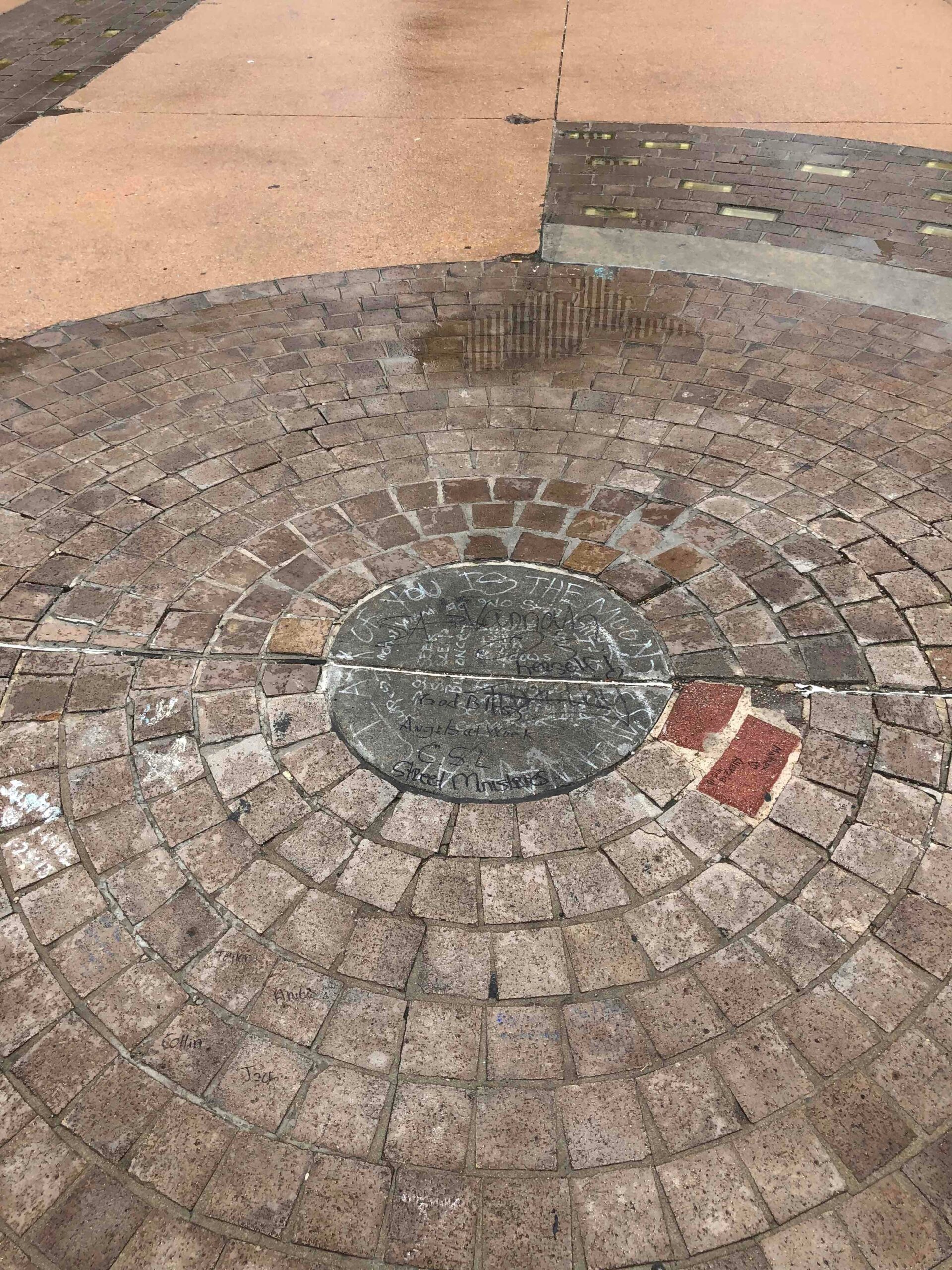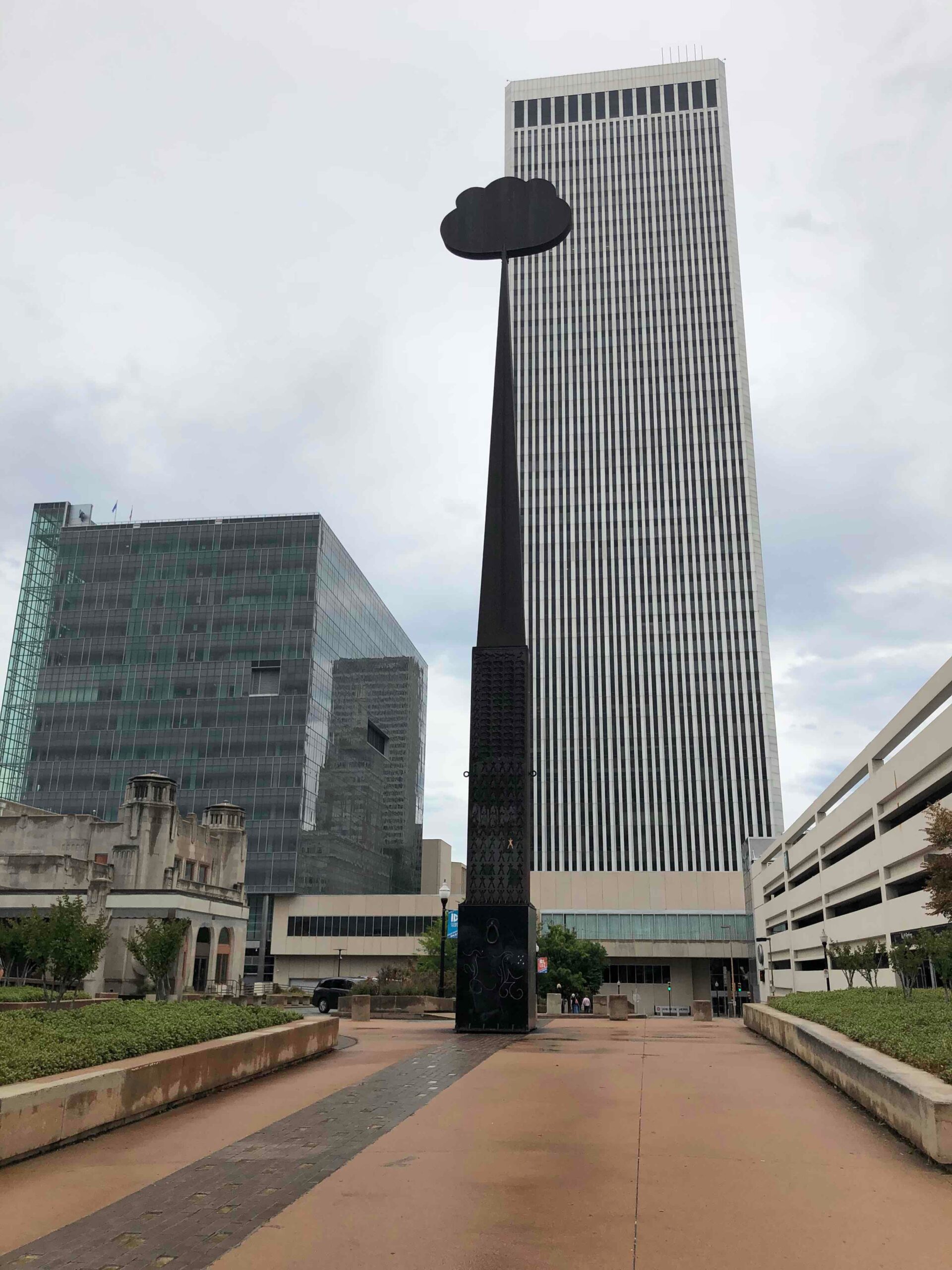Sometimes the most extraordinary road trip discoveries hide in the most unexpected places. Tucked away on a bridge in Tulsa, Oklahoma, you’ll find what locals proudly call the “Center of the Universe”. A mysterious acoustic phenomenon that will leave you questioning the laws of physics and grinning like a kid who just discovered a secret.
Key Takeaways
- A small concrete circle on a Tulsa bridge turns one voice into a loud metallic echo no one else hears.
- Curved planter walls accidentally create the echo effect, a surprise from a 1980s bridge project meant to link Tulsa.
- The Center of the Universe is free, open 24/7 at 20 East Archer Street in Tulsa’s lively arts district.
Don’t expect towering monuments or flashy signs. Instead, you’ll discover something far more intriguing: a worn down concrete circle that holds secrets only revealed to those who stand exactly in its center. This unassuming landmark has been captivating scientists and curious travelers for decades. Once you experience it for yourself, you’ll understand why it’s become one of Tulsa’s most beloved hidden gems.
Why Tulsa’s “Center of the Universe” is a Must-See Roadside Stop
Your first glimpse of the Center of the Universe might leave you wondering if you’ve missed something. There’s no grand entrance or visitor center, just a small, weathered concrete circle marked by a brass plaque that simply reads “Center of the Universe.” This humble circle sits within a larger, eight-foot diameter brick circle, creating a target-like pattern that seems almost too simple to be significant.
Step Into The Concrete Circle and Hear the Strange Echo
But this is where your road trip takes an unexpected turn into the extraordinary. The magic isn’t in what you see, it’s in what you hear when you step into that center circle. Speak, clap, or shout, your voice transforms into something otherworldly, amplified and echoed back to you in a way that sounds metallic, buzzing, tinny, and distinctly louder than it should be. It’s as if you’ve discovered a personal sound booth hidden in plain sight.
The truly mind-bending part? Step just outside that circle, and you’ll barely hear the amplified effect that’s so pronounced for the person standing in the center. This creates a “private amplified echo chamber” that’s both scientifically fascinating and delightfully playful. You’ll find yourself testing different sounds, from whispers to shouts, marveling at how this simple circle can transform your voice into something that sounds like it’s coming from another dimension.
This acoustic anomaly has earned the spot many colorful descriptions from visitors: an urban escape, a whisper chamber, an acoustic playground, and even a cosmic confessional booth. Some couples have chosen it as their proposal spot, while others simply use it as a place to step away from the world and experience something genuinely unique.
The Science Behind Tulas’s Center of the Universe Echo
As you stand in the center, experiencing this acoustic phenomenon firsthand, you might wonder how such a simple structure can create such a profound effect. The answer lies in the surrounding architecture, though this was never the creators intended byproduct.
How the Bridge and Planter Walls Create the Echo Effect
The curved planter walls that surround the circle act as reflectors, concentrating sound waves and bouncing them back to the center point where you’re standing. Think of it as an unintentional acoustic engineering marvel.
This wasn’t some grand design by acoustic engineers; it was a happy accident of architecture. The bridge’s construction in the 1980s, overseen by architect John Laur, was intended as a metaphor and physical link between Tulsa’s north and south sides. The acoustic properties were an unintentional gift that transformed a simple pedestrian bridge into something extraordinary.
You’re not alone in experiencing this type of phenomenon. Similar acoustic anomalies exist around the world, from the famous whispering galleries in St. Paul’s Cathedral in London to the acoustic sweet spots in Grand Central Station in New York. What makes Tulsa’s version special is its accessibility and the community that’s grown around it.

A Bridge Through Time at Tulsa’s Center of the Universe
Your journey to the Center of the Universe takes you across a bridge with its own fascinating history. The Boston Avenue vehicular bridge, where this acoustic wonder sits, traces its origins back to the 1930s. However, the section you’ll be walking on was completed in 1983, rebuilt after extensive fire damage destroyed part of the original structure.
Standing on this bridge, you’re experiencing layers of Tulsa’s urban evolution. The original bridge connected communities divided by railroad tracks, and today’s version continues that mission while offering something the original architects never could have imagined, a place where sound itself becomes a form of entertainment and wonder.
The 60-Foot “Artificial Cloud” Sculpture Watching Over the Circle
Just south of the acoustic circle, you’ll notice the striking 60-foot “Artificial Cloud” sculpture by Warm Springs Apache artist Robert Haozous. Installed in 1992 to commemorate the 1991 Mayfest, this weathering steel sculpture serves as both art and environmental statement. The artist designed it to corrode over time due to pollution, creating a visual reminder of our impact on the environment. As you explore the area, you’ll see how the sculpture has indeed changed over the years, its surface telling the story of Tulsa’s air quality through rust and weathering.
How to Get to the Center of the Universe in Tulsa
Getting to the Center of the Universe is easier than you might expect, though the journey adds to the adventure. You’ll find this acoustic anomaly at 20 E Archer St, Tulsa, OK 74103, accessible 24/7 and completely free – a road tripper’s dream destination.
In the Heart of Tulsa’s Arts District
The best approach is via the Boston Avenue pedestrian overpass, where a brick path leads you directly to the circle. As you walk along this path, you’ll get a sense of the surrounding neighborhood’s character. The Tulsa Arts District spreads out around you, vibrant and eclectic, home to artists, musicians, and small business owners who’ve helped shape this area’s creative identity.
Look around as you approach the circle, and you’ll spot some of Tulsa’s most significant landmarks. The old Union Train Depot sits directly southeast – now home to the Oklahoma Jazz Hall of Fame, it’s another testament to the area’s rich cultural heritage. The Williams Center Tower looms nearby, while the BOK Tower, designed by the same architects who created the World Trade Center Twin Towers, frames the view and provides a striking backdrop for the “Artificial Cloud” sculpture.
The setting creates an interesting juxtaposition – you’re standing in a quiet alleyway, yet surrounded by urban energy and artistic expression. It’s this contrast that makes the Center of the Universe feel like a hidden sanctuary in the middle of a bustling city.

More Than Just an Acoustic Trick
What makes the Center of the Universe truly special isn’t just the acoustic phenomenon, it’s the community and culture that has grown around it. This unpretentious circle has become a beloved gathering place where locals and visitors alike come to share in something genuinely unique.
A Quirky Spot for Proposals, Weddings, and Confessions
You’ll often find couples using the spot for proposals, taking advantage of the intimate acoustic effect to create a moment that’s both private and magical. Wedding parties sometimes stop by for photos, drawn by the spot’s quirky charm and the story it adds to their special day. The circle has become a confessional booth of sorts, where people come to speak their thoughts aloud and hear them reflected back in a way that feels both amplified and contained.
A Real-World Classroom for Design and Architecture Students
The academic community has embraced the Center of the Universe as well. Design students from the University of Oklahoma and other institutions visit to study architectural acoustics, using the phenomenon as an “acousticatalyst” that sparks creative thinking about how built environments can be designed to enhance human experience. It’s a perfect example of how accidental discoveries can become teaching tools and inspiration for future innovations.
From Festivals to TV Shows, Pop Culture Loves this Tulsa Landmark
From 2013 to 2016, the acoustic phenomenon even inspired its own annual celebration – the “Center of the Universe Festival”, a music and street art event held in the nearby Brady Arts District. While the festival has ended, its legacy lives on in the continued appreciation for this unique spot and the creative community that surrounds it.
Pop culture has also discovered this hidden gem. The Center of the Universe appeared in HBO’s “Watchmen” series and was featured in “Tulsa King” starring Sylvester Stallone, where characters used it as a confessional spot. These appearances have introduced the location to viewers worldwide, adding to its mystique and drawing more curious road trippers to experience it firsthand.
Tips for Visiting Tulsa’s Center of the Universe
The beauty of the Center of the Universe lies in its accessibility and simplicity. Unlike many road trip destinations that require planning around operating hours or admission fees, this acoustic wonder is available whenever you are. Whether you’re passing through Tulsa at dawn or midnight, you can stop by and experience it for yourself.
Best Time of Day to Hear the Echo Clearly
However, timing can enhance your visit. Tru to stop by during quieter hours, early morning or late evening, when ambient noise is minimal, and you’ll get the clearest demonstration of the acoustic effect. The surrounding traffic and urban sounds can interfere with the phenomenon, so a peaceful moment often provides the most dramatic results.
Fun Ways to Share the Experience with Friends and Photos
Bring a friend or travel companion to fully appreciate the experience. Having someone stand outside the circle while you’re in the center creates the perfect opportunity to demonstrate how the sound amplification works for you but not for them. Then switch places and let them experience the magic while you witness their amazement from the outside.
Don’t forget to bring your camera or phone to capture the moment, but remember that the real magic is in the auditory experience. Consider recording yourself speaking from within the circle, you’ll be amazed at how different your voice sounds on playback compared to what you heard in person.


